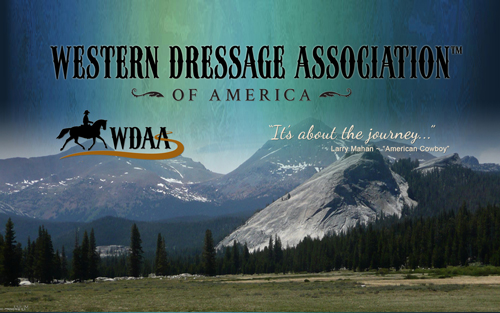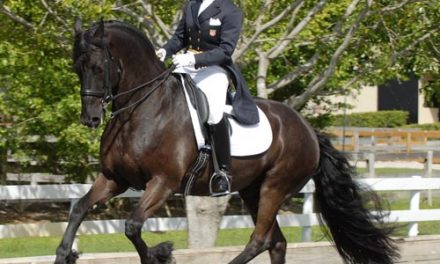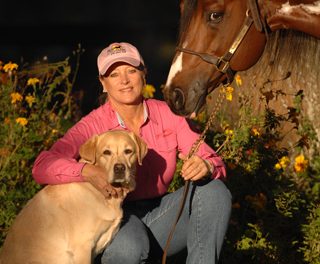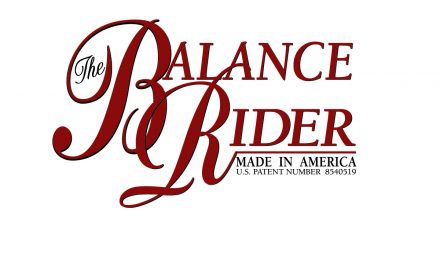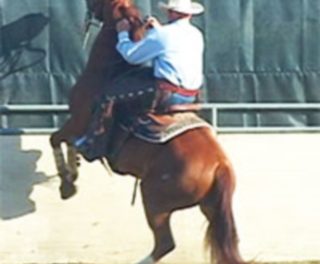 Hackles are easily raised in the world of horses. They don’t often show up on the horses, but their riders can be afflicted with this condition by just about anything out of the ordinary. Something quite out of the ordinary has been happening right here in California and all around the country. The latest hackle-raising within equestrian circles is that there are horses performing dressage moves, and they are wearing western tack. In spite of this, they perform a respectable shoulder-in, a half-pass, and maybe even some fancier moves than those.
Hackles are easily raised in the world of horses. They don’t often show up on the horses, but their riders can be afflicted with this condition by just about anything out of the ordinary. Something quite out of the ordinary has been happening right here in California and all around the country. The latest hackle-raising within equestrian circles is that there are horses performing dressage moves, and they are wearing western tack. In spite of this, they perform a respectable shoulder-in, a half-pass, and maybe even some fancier moves than those.
The good Western trainers and riders are not surprised by this; they’ve been doing it for years. Their reining horses, their ranch horses, and even their trail horses show the result of time spent perfecting dressage techniques. Their horses are supple, they perform harmoniously, and the partnership between horse and rider is evident to just about anyone who can appreciate a good horse. So, what’s new about this?
What’s new is the formation of an organization dedicated to bringing Classical Dressage to the Western horse and its amateur rider. The organization was formed in November of 2010 in Pilot Point, Texas, during a gathering of some well-respected horsemen from the world of Western riding. One of them was Darrell Dodds, publisher of Western Horseman Magazine. Jack Brainard, who helped form the National Reining Horse Association and one of 15 members of President Nixon’s U.S. Horse Industry’s Advisory Committee and recently Western Horseman’s 2010 Man of the Year was another. David Brown was there, well known breeder of cutting horses in Texas. There was also Larry Mahan from the Pro Rodeo Hall of Fame and host of RFD TV’s Equestrian Nation. Eitan Beth-Halachmy, co-founder of Western Dressage and recently inducted into the Morgan Horse Hall of Fame, had established the groundwork for Western Dressage and was there in spirit through conversations he had with Jack Brainard on many previous occasions. Unable to attend, Eitan was still recovering at his ranch in California after collapsing at the end of his performance for the World Equestrian Games in Kentucky earlier that year.
These men talked about the advantages of Classical Dressage training and how its philosophy and application to Western horses could open doors to so many Western riders who were looking for more relaxation and enjoyment with their horses. They wanted it to be fun and educational and safe. In a slightly different twist to rein contact, they wanted a softer and lighter way of going than is typically seen in modern dressage. They wanted to help horse owners, no matter what breed of horse they owned, or how they used their horses, to learn some basic Classical Dressage training methods in order to improve the training of their horses
and their own horsemanship.
In recognition of the downturn in the economy, these horsemen believed that new ways needed to be found that were affordable for the average horse owner, ways that could be taught through clinics given by knowledgeable trainers, and even through online video coaching and judging by qualified trainers and judges. It was decided to open it to all horses, no matter the breed. From Morgans to Quarter Horses to Arabians to American Saddlebreds, anyone riding in a western saddle and tack was welcome to participate. Even gaited horses, who historically played a big part in the settlement of the American West, were to be encouraged for their own division. Including all breeds was an important consideration.
To make sure that the concept of Western Dressage stayed to a path that was beneficial for the horse and rider, one that used humane and effective techniques that took into consideration the bio-mechanics of the horse and one that followed a mission statement to honor the horse, the organizers wanted the focus of the association to be educational and directed at the wellbeing and soundness of the horse. It needed a set of standards to be developed and articulated toward that goal.
The organization that would be charged with developing these standards was named the Western Dressage Association™ of America or WDAA, and they appointed an executive board of directors to get it off the ground. The new association’s executive board consisted of people who were familiar with both horse organizations and nonprofit issues (Ellen DiBella, Barbara Molland, Neide Cooley, and Bonnie Glasgow). The WDAA would become responsible for the
establishment of rules and standards which would eventually be proposed to the United States Equestrian Federation, the official oversight organization that handles all equine competition matters in the United States. Later, Georgie Green, Karen Homer-Brown, and Julie Vosberg joined this group.
In recognition of a grass roots approach to address growth of the discipline, the WDAA began a process of establishing recognized Affiliates throughout the country, each one committed to the same standards and concern for the horse. These Affiliates were all based on the individual State’s rules of incorporation. They had to be nonprofit, and their goal was to educate Western riders about Western Dressage in a manner consistent with the Mission Statement of the Western Dressage Association™ of America. A rigorous process of approval followed to ensure that the education offered by the Affiliate to both rider and horse was consistent with the original intent.
The good news for Californians is that California’s Affiliate, through this thorough process of approval, has just been formed and accepted in Sonoma County. It has elected a Board of Directors, and has been incorporated with the State. The Western Dressage Association™ of California received its official acceptance at the end of 2011, and by the time you read this, it will have its own website and membership capability.
According to the WDAA which tracks membership throughout the country, California has more interested Western Dressage members than any state. California will benefit exceptionally from the formation of this new Affiliate, and the growth of Western Dressage will mean great things for the entire horse industry here in the West. Despite the appearance of several For Profit businesses promoting themselves as Western Dressage organizations, the Western Dressage Association™ of California is the only organization endorsed and approved by the Western Dressage Association™ of America for California.
The Western Dressage Association™ of America is witnessing explosive growth both in this country and around the world with Alliances forming in Canada (such as the nonprofit Western Style Dressage Association of Canada), Great Britain, Germany, and Australia. On the business front, the Circle Y Saddle Company has just produced a Western Dressage saddle and it is selling well.
The Western Dressage Association™ of California is now seeking new members as well as people interested in serving on its Board of Directors and on its many committees. It encourages anyone with professional expertise in law, business, marketing, website development, graphic design, artistic skills, public speaking, etc.. to consider serving on its board. It also encourages qualified trainers to consider bringing their knowledge of Classical Dressage to the attention of Affiliate organizers as the Affiliate plans to set up a series of clinics and schooling shows throughout California for 2012. All contact information can be found on the California Affiliate website (www.wdaca.org) as well as the Western Dressage Association™ of America’s website (www.westerndressageassociation.org).
The Western Dressage Association™ of California is based in Sonoma County where there is historically so much interest in horses. Many Sonoma and Bay Area residents may have already had a taste of the possibilities in recent years after seeing Eitan Beth-Halachmy perform a freestyle Western Dressage exhibition at Dressage in the Wine Country. Additionally, Susan Tomasini, another Western Dressage trainer based here in Sonoma County, performed her own exhibition of Western Dressage at the same venue in 2011. Several other trainers in the area have begun giving lessons and clinics and training in Western Dressage: Dean Voigt of Santa Rosa, a friend of Jack Brainard and a Founding Pioneer of the WDAA and Julie Renfro-Cross are two trainers involved with Western Dressage. Besides Co-Founder Eitan Beth-Halachmy of Grass Valley and his wife, Debbie, who has been an organizational force for Western Dressage, other Californians such as Diane Olds Rossi and Julie Adams, both of Grass Valley, Lyn Ringrose-Moe of Vacaville, and Jec Aristotle Ballou of Santa Cruz, all serve on the WDAA’s Advisory Board and offer their knowledge, instruction, and training in Western Dressage.
In other parts of the country, Julie Goodnight, Lynn Palm, Lester Buckley, Pam Fowler Grace, Gareth Selwood, Bob Ruxer, David Brown, Darrell Dodds, Anita Owen, Kathy Meyer, Barbara Long, Cliff Swanson, and Dr. Robert Miller (who is Western Horseman’s 2011 Man of the Year) have lent their expertise in so many ways to the Western Dressage Association™ of America by becoming members of its Advisory Board and contributing their wisdom and experience with horses to WDAA.
Closer to home, the Western Dressage Association of California’s Board of Directors is made up of Terry Tomasini, President, Vice President Julie Renfro-Cross, Secretary Judy Tamagni, and Treasurer Allison Lake. Additional help and ideas have been contributed by Dean Voigt, Wanda Smith, Tracy Underwood, Jec Ballou, Amanda Prestly, Marian Taylor, Ramsay Metcalf, Rhonda Azevedo, Roni Brooks, Terry Church, and Susan Tomasini.
So, if it is time to turn over a new leaf in 2012, to get back in the saddle if you have been out of it for a while, you should consider trying this new discipline. If you have a young horse you would like to start in a way that will help him and you for the rest of your riding life or an old horse needing a new job, and if you want to have fun doing it, consider joining the Western Dressage Association™ of America and the Western Dressage Association™ of California.
Much information about the development, the philosophy, and the news and events
surrounding Western Dressage can be found on the national organization’s website: www.westerndressageassociation.org. More information about membership, upcoming meetings, and development of the Board of Directors and the various committees of the Western Dressage Association™ of California can be addressed to its current President, Terry Tomasini, at terry@tomasini.us.

